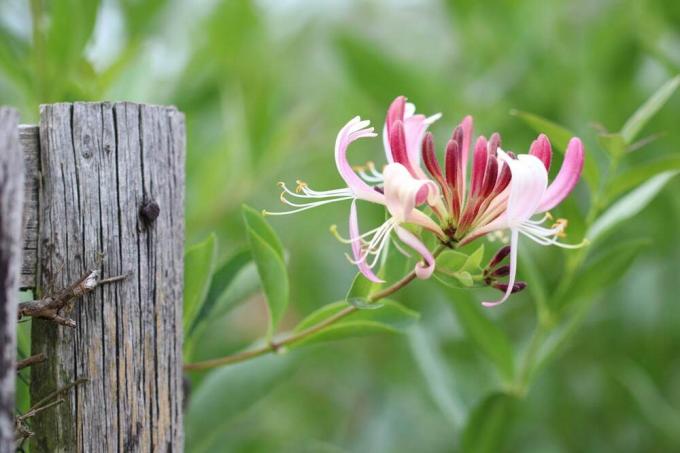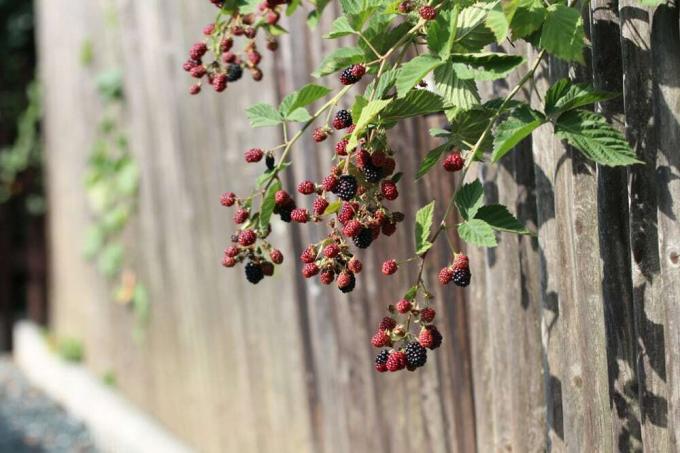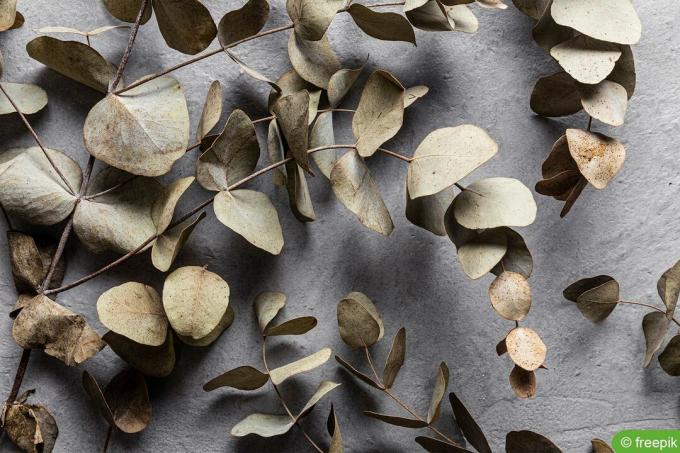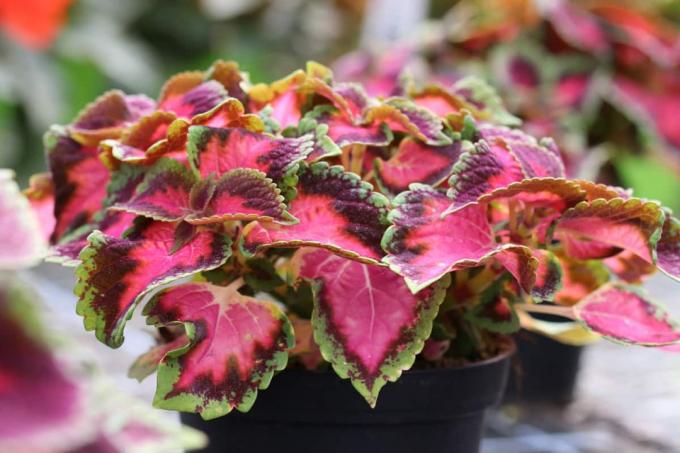

Table of contents
- ivy
- Evergreen Clematis
- Evergreen honeysuckle
- Evergreen creeper
- Real blackberry
Evergreen creepers can beautify many areas in the garden. These plants do not form trunks and cannot support themselves. Therefore, the right location and a supporting trellis are extremely important, for example on walls or a climbing frame. The creepers can grow up these and often form immense carpets of leaves. In the local latitudes, care must be taken to ensure adequate winter hardiness.
ivy
Ivy is a particularly hardy creeper that can withstand the extremely cold temperatures of winter. The plant, which is native to this country, bears the botanical name Hedera helix and makes only low demands on the climate and solar radiation. Due to its high growth rate, the ivy is suitable as a reliable privacy screen all year round. There are various variants to choose from, which differ in the leaf colors. The adaptable climbing plant grows on almost all soil qualities and has robust characteristics. The ivy is ideal for greening dead trees, facades, fences, railings, walls and pergolas. A single plant alone can cover an area of up to 500m². If the ivy gets too big, it can even damage the masonry. Removing unwanted parts of the plant is often difficult because the adhesive roots get stuck on the ground.
- A north to west facing location is ideal
- Vigorous growth, annual increase is approx. 2m
- Can reach growth heights and lengths of up to 25 m
- However, it only develops weak adhesive roots
- Depends on support from climbing aids
- Foliage is dark green and star-shaped
- Inconspicuous, yellowish-green umbels of flowers
- Flowering time from September to October
- Forms pea-sized black berries, these are poisonous
- Prefers loose, humus-rich and slightly moist plant substrate
- Does not like compacted soil
- Calcareous substrates are ideal
- Does not tolerate acidic pH
Evergreen Clematis

There are countless cultivars within the clematis family, some of which are also evergreen. These include the specimens of Clematis armandii, which keep their leaves throughout the winter. These look similar to rhododendron leaves and are an ornament for fences and facades. Unlike the ivy, the lush flowering of the clematis on the dark foliage is a real eye-catcher. The clematis is sensitive and is therefore happy about a sheltered location. In order to protect the root ball from drought and excessive sunlight, a weakly consuming underplanting that does not compete with the clematis is a good idea. If the clematis is cultivated as a container plant, the pot should be insulated in winter to protect it from frost levels that are too severe. But even at exposed altitudes, the clematis in the garden is happy about additional winter protection.
- Woody creeper with manageable growth
- Climbs up to 3 m high
- Requires supporting trellis or climbing aid
- Ideal for east and west sides of buildings and facades
- Thrives in light to partially shaded locations
- Does not tolerate permanent solar radiation
- Well suited as a container plant
- Leaves are oblong and fleshy
- Forms fragrant white or pink flowers
- Flowers already at the end of winter, from March
- Absolutely prevent waterlogging
- Prefers loose and humus rich soil
- Does not tolerate extremely severe frost
- Cover the ground with brushwood or fir branches to protect it
Evergreen honeysuckle

The evergreen honeysuckle has the botanical name Lonicera henryi and is ideal for greening walls, fences and pergolas. After a while, however, the climbing plant will cover unsightly wall crowns and columns with its twisting shoots. However, the evergreen honeysuckle is not quite as vigorous as the ivy. If a dense and beautifully closed wall of leaves is desired, climbing aids are required. These counteract slipping of larger specimens. Freshly planted honeysuckles look forward to additional winter protection in the first year, especially at exposed altitudes. If the location is too shady, Lonicera henryi will bare from below. If the sun is too strong in winter, there is a risk of unsightly burns. Since the plant is often infested with lice, it should be checked regularly.
- A slightly sunny to partially shaded location is ideal
- Large leaves are lanceolate and fresh green
- Forms yellow-red, rather inconspicuous flowers from June to August
- After that, small and round berries appear, with a blue-black coloration
- Reaches heights of growth of up to 8 m and widths of up to 4.50 m
- Medium vigorous growth, between 30-60 cm per year
- Use vertical compartments or net-shaped trellis
- Supporting transverse elements and branches are decisive
- Distance to other plants should be at least 2 m
- Prefers nutrient-rich, fresh to moist plant substrate
- Calcareous soils are ideal
- Shade the base of the trunk to protect against drought
Evergreen creeper

The evergreen creeper bears the botanical name Euonymus fortunei and is a rather weak-growing creeper. Therefore, it is well suited for greening unsightly wall bases and low walls that are to be covered. But other unsightly areas in the garden can also be hidden behind it. If it comes into contact with the ground, new roots will form immediately at this point. For this reason, the Evergreen Creeping Spindle is also very suitable for fortifying slopes. Thanks to strong adhesive roots, the plant can easily climb up walls, but this takes time. The leaves of the climbing plant have a strong luminosity and make for an attractive eye-catcher. Euonymus fortunei has robust characteristics and is almost as hardy as ivy. In the bucket, however, the climbing plant only tolerates temperatures of down to -5° C in winter.
- Grows as a groundcover and climber
- Tolerates both partially shaded and sunny locations
- Thrives on all soil qualities
- Leaves are light to dark green and grow close together
- In autumn the color changes and the foliage becomes redder
- Depending on the variety, the foliage even turns crimson in winter
- Grows about 40-60 cm high and usually twice as wide
- Doesn't grow much or very fast
- Height increase is approx. 20 cm per year
- Forms a dense carpet of leaves over time
- Rather inconspicuous flowers only mature on older specimens
- Flowering time is from May to July
- After flowering, small reddish fruits ripen
- Can be kept as a container plant
- But then it needs extra protection in winter
- Pack the tubs well during the winter months when temperatures are below zero
Real blackberry

The blackberry bears the botanical name Rubus sectio Rubus and is well suited to the local temperatures due to its evergreen leaves. The native climbing plant has a lush growth and soon develops delicious berries. Due to the many thorns, this is ideal for enclosing gardens to prevent unwanted entry. With the help of trellises, the blackberry can be cultivated on walls as espalier fruit. Then the fruits can be harvested much more easily and the plant also serves as a decorative wall covering. Warm and humid conditions are ideal for better fruit development, the location should be protected from wind and weather. The vegetation of the blackberry can quickly get out of hand and therefore become a nuisance. The thorny climbing shrub often spreads to unwanted places in the garden and is difficult to remove.
- A multi-branched and prickly climbing shrub
- Does well in full sun to part shade
- Wind-protected locations are ideal
- Well suited as trellis fruit
- Grows in almost all soil qualities
- However, it does not tolerate soil that is too dry or too poor
- Reaches growth heights of 0.5-3 m, single specimens up to 4 m high
- Pinnate leaves are dark green on top and much lighter underneath
- Leaves are not shed in fall but remain until spring
- Forms white flowers from June to August
- Blue-black fruits ripen from July to September
- Support growth with wire frames or climbing aids
- When cutting back, there is a risk of injury from sharp thorns
 garden editorial
garden editorial I write about everything that interests me in my garden.
Learn more about overwintering plants

Eucalyptus dries up during the winter: what to do?
Eucalyptus in tubs spends the winter best in a frost-protected place in the house. It is not uncommon for the beautiful eucalyptus plants to dry up during the winter. We show what you can do about it.

Is bamboo hardy? Hibernate bamboo correctly
A bamboo can undoubtedly enrich any garden. But can it survive winter temperatures in good health? There is no general answer. It depends on the species and what winter protection it gets.

Is the colored nettle hardy? 6 tips for wintering
Summer is the season when the colors of these ornamental foliage plants are at their most intense. Most of the leaves are multicolored, with different drawings, wavy or heavily slit edges.

Is Camellia japonica hardy? Overwinter camellia properly
Anyone who sees a blooming camellia for the first time will definitely be amazed. The attractive plant, which came to Central Europe from Japan and Korea, has taken the hearts of hobby gardeners by storm. It is usually cultivated in tubs. Is she hardy?

Is the magic flower hardy? | Overwinter Mirabilis jalapa
The Japanese miracle flower (Mirabilis jalapa) delights its viewers with its bright and colorful flowers from June to October. It carries up to five different colored flowers on one and the same plant. Even a single flower can be multicolored.

Is rhododendron hardy? 6 tips for wintering
Overwintering rhododendrons: With these 6 tips you can get the azaleas through the winter safely!



